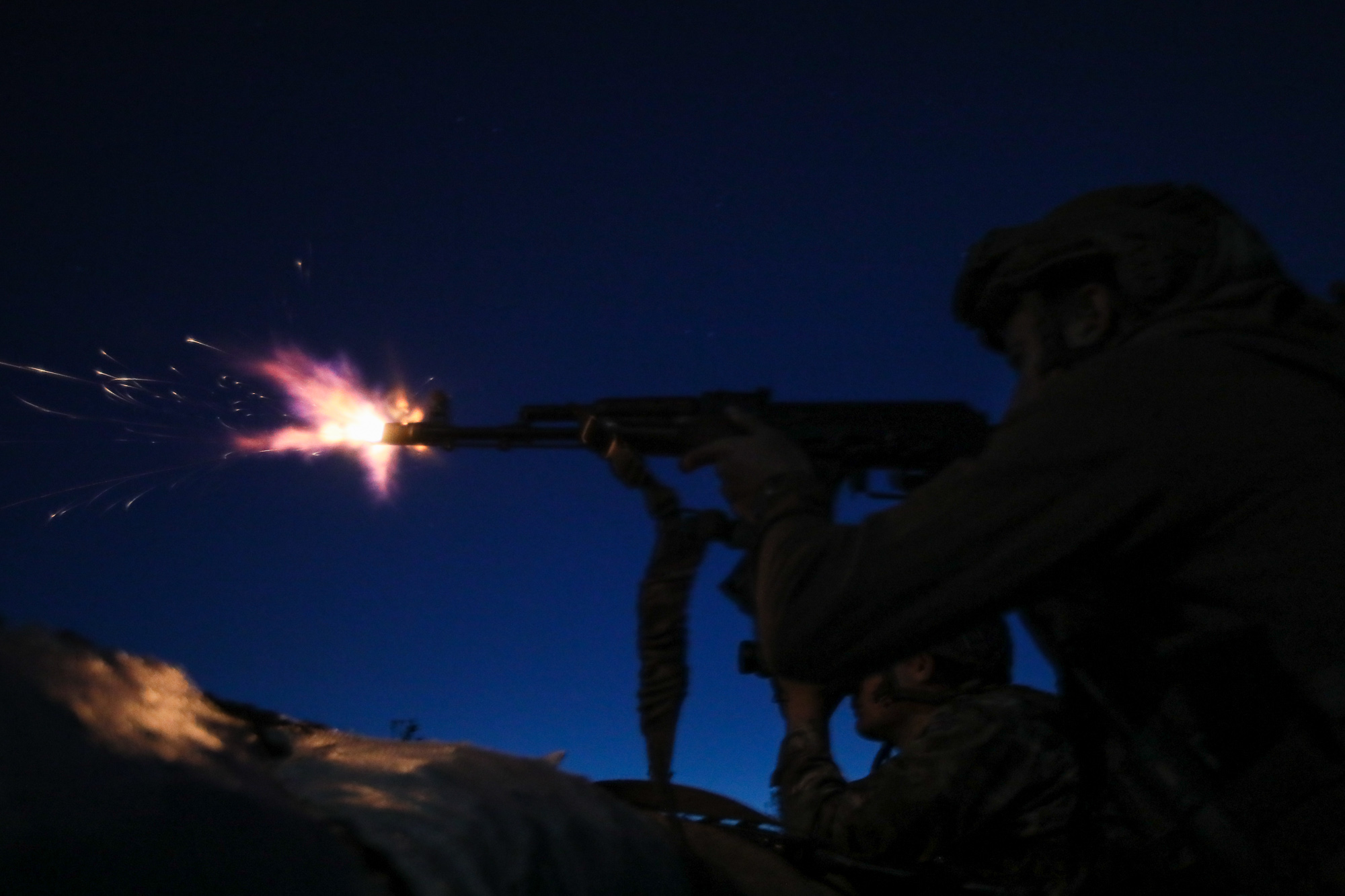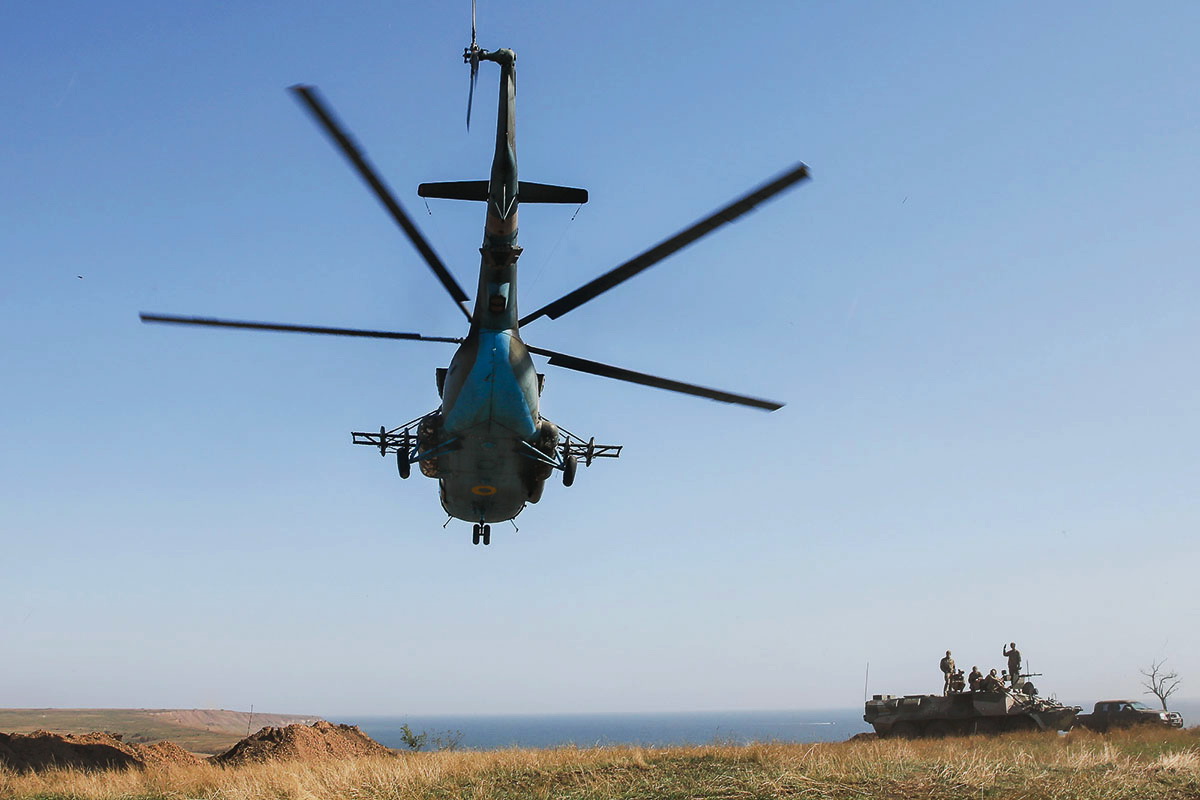As Ukraine turns 28, its defense and security sector has undergone major changes in leadership to meet the daily grind of Russia’s war.
As a result of the recent defense corruption scandals and the 2019 elections, protégés of former President Petro Poroshenko lost their patron and the defense and security leadership changed almost completely.
President Volodymyr Zelensky appointed Poroshenko’s opponents to key posts, promising to reinvigorate reforms and the war on corruption, both of which were blunted by the ex-president.
Nonetheless, as the new team assembles, the military threat to Ukraine’s existence remains. In vast expanses of the Azov and the Black seas, the diplomatic halls of Europe, and the trenched battlefields of Donbas, the Kremlin is still pressuring Ukraine to surrender and return to Russia’s sphere of influence.
Defense and politics
The 28th year of Ukrainian independence saw tensions rise in the maritime domain, with Russia illegally monopolizing the Azov Sea. The conflict peaked on Nov. 25, 2018, when the Russian coast guard attacked three Ukrainian navy vessels headed for the Kerch Strait and detained all 24 Ukrainian sailors on board. For the first time, Russian forces openly attacked Ukraine under their own colors, following years of proxy war in Donbas.
The incident led to an unprecedented 30 days of martial law in 10 regions of Ukraine in November-December amid fears of an all-out Russian invasion. However, martial law had virtually no effect on the country whatsoever. Ukraine did not launch a general or partial mobilization. No military-led wartime administrations were established, and no additional defensive barriers were set up.
The decision to initiate martial law backfired for Poroshenko: He was widely criticized for supposedly attempting to use it to postpone or cancel the upcoming presidential election, while his chances for re-election already looked weak.
Starting in February, a headline-grabbing investigation by the Bihus.Info journalism project delivered an even bigger blow. It exposed millions of dollars of defense procurement corruption involving the son of Oleh Hladkovskyi, the deputy secretary of Ukraine’s National Security and Defense Council.
Hladkovskyi, Poroshenko’s appointee and long-time business partner, was fired but not prosecuted. He was replaced by Colonel Serhiy Kryvonos, a reputable war veteran with a pro-reform and anti-corruption agenda for UkrOboronProm, the state-run defense production giant.
But Poroshenko was already likely doomed as a presidential candidate.
Even in the army deployed to Donbas, his supposedly rock-solid electoral base, Poroshenko just barely scraped by with a win during the presidential elections, having secured only a bit more than half of the soldiers’ votes.
New faces?
Poroshenko’s defeat very soon led to the downfall of his power vertical in the sector.
President Zelensky started appointing his own team of individuals who had not been stained by corruption scandals and were not considered loyal to Poroshenko and his team.
The most striking example of this is in the Armed Forces. In one of his very first decrees on May 21, Zelensky dismissed Poroshenko’s close ally, Chief of General Staff Viktor Muzhenko, and replaced him with his bitter adversary, General Ruslan Khomchak, known for his role in the disastrous battle of Ilovaisk.
Contrary to the apocalyptic forecasts by Poroshenko supporters in media, the new top military commander confirmed he would continue NATO-style reforms and work to improve living standards for military personnel.
Soon, many of high-ranking officers loyal to Muzhenko and Poroshenko were pushed into the background by Khomchak in favor of those outside the old ruling clan. Just recently, on Aug. 5, Zelensky promoted Lieutenant General Oleksandr Syrskiy, then top commander of the contingent in Donbas, to lead the Ground Forces on Khomchak’s recommendation. This is one of the most crucial posts in the Ukrainian military.
Also in August, General Viktor Nazarov, a close and powerful ally of Muzhenko sentenced to seven years in prison for negligence, decided to leave the military service and continue appealing his sentence.
In some cases, Zelensky opted to replace Poroshenko’s people in other law enforcement and security agencies with distinguished combat military officers who did not occupy key posts under Muzhenko. In late May, he fired controversial former Defense Minister Valeriy Heletey from his post in the State Guard Administration and replaced him with Oleksiy Otserklevych (known by his nom-de-guerre Kupol), a hero of the Battle of Donetsk Airport.

A Ukrainian soldier engages the enemy during a combat clash with Russian-backed militants near the town of Novoluhanske, eastern Ukraine, overnight into June 15, 2019. (Volodymyr Petrov)
The same outcome — dismissal — was prepared for Vasyl Hrytsak, whom Poroshenko awarded the title of “Hero of Ukraine” in the final days of his presidency.
Key staff changes also occurred in security policymaking: Oleksandr Turchynov, the long-time secretary of the National Security and Defense Council, left and was replaced by former finance minister Oleksandr Danyliuk, another harsh critic of Poroshenko.
The never-ending and unsuccessful saga of reforming UkrOboronProm under Poroshenko only got rolling after Zelensky appointed Aivaras Abromavicius, the former economy minister who had resigned after accusing Poroshenko’s entourage of patronizing corruption, to head UkrOboronProm’s supervisory board.
Abromavicius has already made some headway by launching yet another Hr 32.5 million ($1.2 million) tender to hire an international audit company to scrutinize UkrOboronProm, a bottomless black hole for taxpayer money.
Abromavicius is about to finish obtaining the dismissal of UkrOboronProm Director-General Pavlo Bukin (a figure in Hladkosvkyi’s corruption case): On Aug. 19, news broke that the Cabinet of Ministers had approved the candidacy of manager Oleksiy Timofeyev, which was proposed by Abromavicius.
Naval buildup continues
Over the past year, the defense and security sector has also seen several important steps forward, although many of them ended up half-hearted or insufficient.
Tensions with Russia in the Azov Sea region have demonstrated the country’s defenselessness from the sea. They also brought long-overdue plans to enhance coastline defenses into the spotlight, resulting in the armed forces intensely training to defend from a potential massive Russian amphibious assault.
Ukraine also laid the first cornerstone of a new full-fledged naval base in the city of Berdyansk last September to uphold Ukraine’s maritime presence in the Azov Sea, although it is not likely to become fully operational until the mid‑2020s.
By early 2019, the military had produced the first comprehensive plan for naval development envisaging building a “mosquito fleet” of small, but powerful and maneuverable missile boats supported by corvettes.
By 2035, this navy should become capable of operating all across the world ocean — but the most recent progress in shipbuilding has not given much reason for optimism. In fact, the only considerable ships expected to join the Ukrainian navy in 2019 are two Island-class patrol boats provided by the United States Coast Guard at no cost.
On the other hand, the naval threat from Russia has intensified Ukraine’s missile program. Against expectations, in 2019 the missile systems Neptune and Vilkha, created almost from scratch in Ukraine, entered their final tests before being accepted in service and becoming a deterrence weapon against a Russian amphibious assault.

A Ukrainian navy Mikoyan Mi-8 helicopter flies over a simulated target during live fire drills at the Azov Sea coastline close to the town of Urzuf on Oct. 9, 2018. (Volodymyr Petrov)
Ups and downs
Over the past year, the first key provisions of the 2018 National Security Law came into effect, making Ukraine’s security sector closer to Western benchmarks. In particular, the Ukrainian defense minister is now an appointed civilian in compliance with the Western principle of civilian control of the military.
However, for now, this is largely a technicality. In October 2018, Poroshenko simply retired General Stepan Poltorak from military service and immediately reappointed him again as a newly-minted civilian defense minister.
Among the promising developments of the past year is also the inception in late November of the very first Ukrainian Ministry of Veteran Affairs, formed to care for the estimated 1 million Ukrainians who have participated in conflicts from World War II onward.
Some things that had been awaited for years were realized only in 2019, too. On June 6, the Rada finally voted to simplify obtaining Ukrainian citizenship for foreign fighters helping defend Ukraine in Donbas.
The Rada was also keen on enshrining Ukraine’s integration into NATO and the European Union in the Constitution — a measure pushed through by Poroshenko in February, shortly before presidential elections, although it provided very little practical meaning.
But when it came about introducing real, painstaking transformations into military service, the Rada would decisively turn a deaf ear: Several times, it effectively ignored key bills on implementing a new NATO-compatible system of military ranks, with Western-style corps of non-commissioned officers, as well as numerous amendments aimed at modernizing military service manuals.
Ukraine must complete its national defense reform program to reach full compliance with NATO benchmarks by the end of 2020.
Peace for Donbas
While Kyiv was boiling with big-time changes and reforms, the scorched trenches of Donbas remained frozen in the grips of never-ending, static warfare.
Except for a few tactical advancements of Ukrainian forces slowly creeping toward enemy lines by hundreds of meters, the battleground map has seen no major changes.
In early 2019, a horrifying casualty toll in Donbas was published by the United Nations: over 13,000 killed and 30,000 wounded since 2014. According to estimates from open sources, at least 127 Ukrainian soldiers were killed in action between August 2018 and August 2019 alone — without a single prospect of peace.
President Zelensky, however, came to power with an agenda different from Poroshenko’s “no peace, no war” approach.
While the Minsk negotiation group kept routinely concluding new armistices that failed within hours, Zelensky came promising to finally find a way to end this war.
Under his leadership, something unexpected happened in Donbas: For the first time in years, the opposing forces started a mutual troop withdrawal in the combat area near the trans-frontline crossing point of Stanytsya Luhanska near occupied Luhansk.
But deaths of Ukrainian servicemen despite the ceasefire and Russian-backed forces’ apparent reluctance to pull back and dismantle their battlefield fortifications have proved that Zelensky’s optimism was somewhat naïve and peace for Donbas remains an open question.
